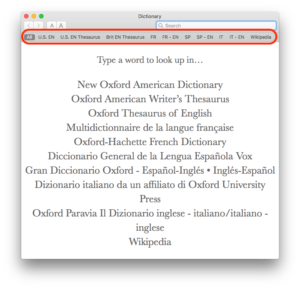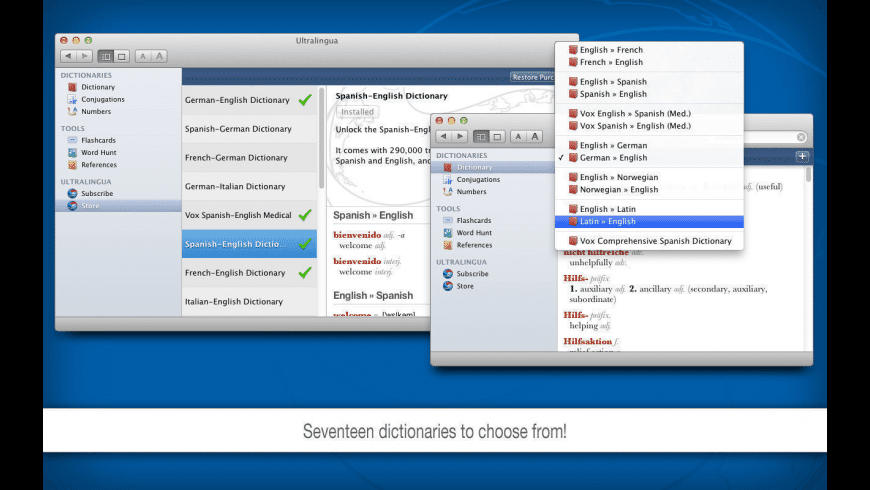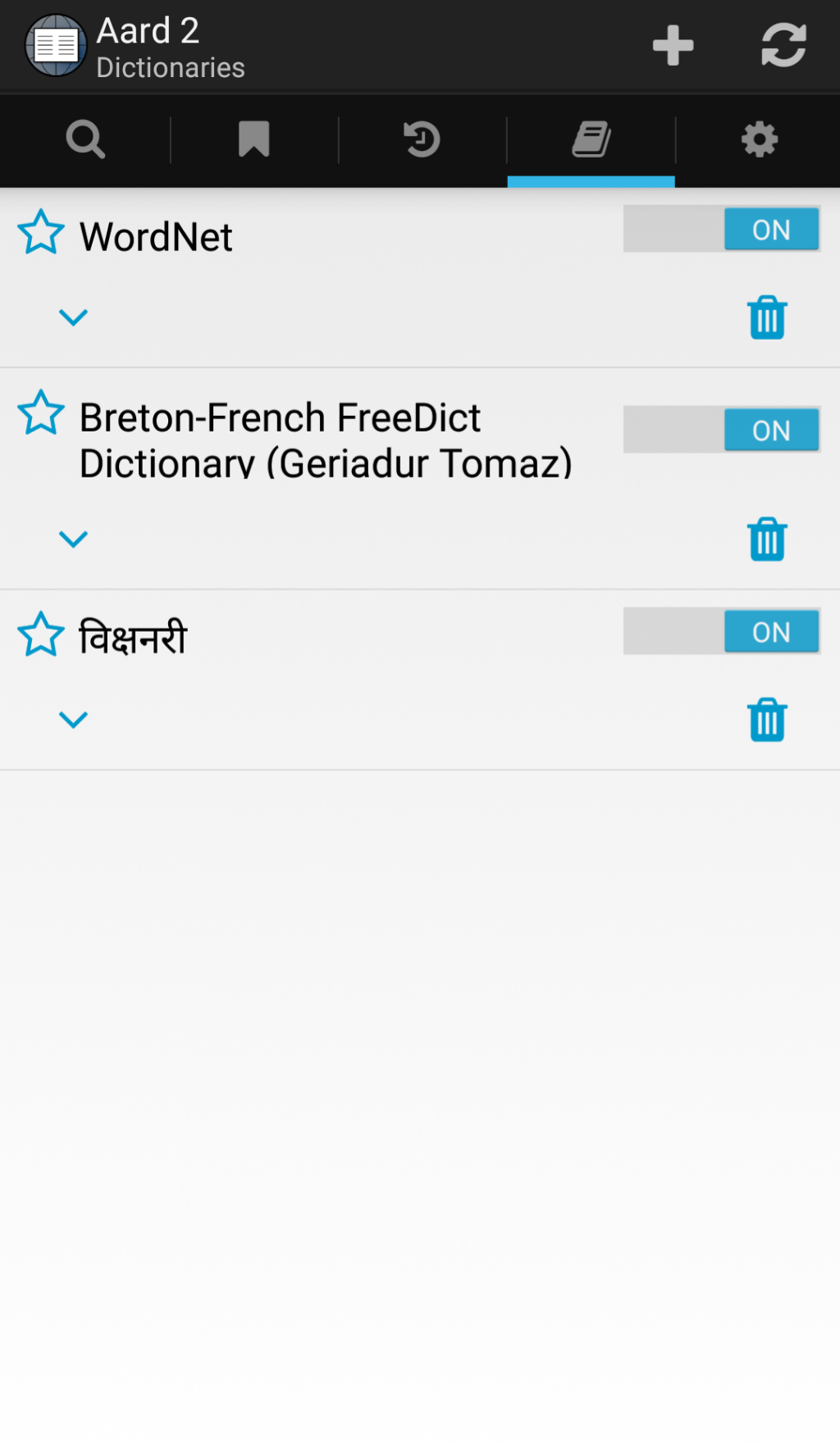The Dictionaries app fixes that. Dictionaries installs language support and deeply integrates it into macOS. The dictionaries work exactly like Apple's own and are available everywhere: in all your. 4 Best Free Offline Dictionaries For PC Windows 10 Windows 7 Windows 8 Linux Mac To Look Up Words Offline Without Internet Click here to free download offlin. By default, the Dictionary app has ten single-language dictionaries, three bilingual ones, and two thesauruses, as well as Wikipedia and a dictionary for Apple's system terms. If you have a dictionary file in the stardict format, you can convert it to one that works with Dictionary using DictUnifer, a free tool created for this very purpose.
The built-in Dictionary app in macOS is hardly the sexiest piece of software out there, but it is a crucially overlooked resource. When combined with the context menu's 'Look Up' function, it makes both learning words and using words correctly far easier. And for folks learning another language, it's crucial to getting translations right. It's already on your Mac: you just need to use it.
Merriam Webster dictionary and thesaurus Free to try Fogware Publishing Mac OS X 10.4 Intel/10.5 Intel/10.6 Intel Version 4.0 Full Specs Download Now Secure Download. Set 'Allow applications downloaded from' to 'Mac App Store and identified developers' now install the MDBG Chinese-English Dictionary for macOS after the installation you can change the security setting back to it's original state.

Using Dictionary
The easiest way to access the information stored in Dictionary is through a right-click. Select a word, then right-click on it. You'll see Look up word as a context menu option. Select that, and a contextual popup will appear over the highlighted word, over a definition or even a preview of the associated Wikipedia page. The dictionary is slightly limited compared to something like the Oxford English Dictionary, but it includes a large enough selection to get things done in common English.
You can also open the Dictionary app from /Applications/Dictionary.app or through Spotlight. From there, you can search any dictionary specifically and access the thesaurus, perhaps the least-understood and most poorly used tool for writers of all skill levels. Quick tip for proper thesaurus use: remember that synonyms in a thesaurus are not perfect replacements. You still need to know the definition and connotation of the word before dropping it into your writing.
Adding Dictionaries to the Dictionary App
Dictionaries can be added from the library of available dictionaries. There are dictionaries for every language supported by macOS, as well as a number of additional English dictionaries that are useful to writers and students.
Open the Dictionary app's preferences (Dictionary > Preferences in the menu bar or Command + ' on your keyboard.) This reveals a large list of all the available dictionaries within the application
Select the dictionaries you want to appear by checking the boxes next to their names. Dictionaries are arranged alphabetically based on their language.
At the bottom, you'll find a few additional English dictionaries and thesauri, which can be quite useful to students and writers.
Changing Dictionary Names
Many of the dictionaries have unhelpfully short titles. By renaming dictionaries, we can see the relevant information about all the installed dictionaries at once.
To rename a dictionary, right-click on the dictionary in the toolbar and choose Edit Label from the context menu.
Type the dictionary's new name in the text box and click 'OK' to apply the change.
Importing Custom Dictionaries
Theoretically, custom dictionaries can be imported in the Dictionary app. If you can find one. Many of the websites that hosted custom dictionaries are now defunct.
Dictionary files are stored in ~/Library/Dictionaries which can be accessed directly from Finder or by choosing File > Open Dictionaries Folder in the Dictionary app.
Once you've found a dictionary in the .dictionary format, you can place it in that folder. The Dictionary app will automatically load it the next time it's opened.

There are not many active websites that offer dictionary files for download, unfortunately. The major ones, like StarDict, have closed up shop for one reason or another. As of writing, clasqm has some dictionaries available for multiple foreign languages available for download on his website.
Conclusion: Creating Dictionaries
There are also instructions for converting other types of dictionaries to the Apple format using pyglossary. It's a complex process, but it is functional. If you don't experience using Python in Terminal or installing software with a command-line package manager, you might want to read up on those before you begin.
With pyglossary, you can convert Babylon (BGL) dictionaries to .dictionary files. The good news is that there's an abundance of Babylon dictionaries, from linguistic to technical. Find the library of Babylon dictionaries here. We were able to make the conversion process successfully, so we can confirm this method is functional as the time of writing.
We can also confirm that a once commonly-used tool for this process, DictUnifier, does not function in modern versions of macOS. It will open, but that's it.
A third-party program, Dictionaries.io, can add many multilingual spellchecking dictionaries to Dictionary.app. It is paid software, but it's less than $10 for a license. If you're frequently working with multiple languages, it's likely the best dictionary tool for the job. It also natively supports more languages than Dictionary.app and provides spellchecking in non-English languages. It can't support external dictionaries, but the included library is expansive.
If you're interested in exploring lesser-known macOS apps, you may also like the following posts:
Select version: Select version:With Dictionary on your Mac, you can easily get definitions of words and phrases from a variety of sources.
Tip: You can also quickly look up words while you're working in an app or browsing webpages.
You can open Dictionary from Launchpad (click the Launchpad icon in the Dock).
Search for a word or phrase in Dictionary

In the Dictionary app on your Mac, type a word or phrase in the search field in the upper-right corner of the Dictionary window.
Note: If you add another Dictionary source, wait for it to download completely before searching for a word or phrase. For information about adding sources, see 'Customize Dictionary sources' below.
While reading the definition, you'll see links (blue text) to related words. In addition, you can hold the pointer over any word or phrase and click to look up its definition.
When you look up a word in a definition, a SnapBack button appears in the search field. Click it to return to your starting definition. You can also swipe left or right on your trackpad or click the previous or next button in the toolbar of the Dictionary window to move between definitions you viewed.
Make text smaller or bigger
In the Dictionary app on your Mac, click the font size buttons in the toolbar of the Dictionary window.
You can also pinch with two fingers to zoom in or out.
Customize Dictionary sources
In the Dictionary app on your Mac, choose Dictionary > Preferences. You can select and reorder sources, such as Spanish or Korean dictionaries. You can set options for some sources, such as how to display pronunciations or which language of Wikipedia to search. The sources you select here determine the sources shown in Dictionary and when you look up words.

Using Dictionary
The easiest way to access the information stored in Dictionary is through a right-click. Select a word, then right-click on it. You'll see Look up word as a context menu option. Select that, and a contextual popup will appear over the highlighted word, over a definition or even a preview of the associated Wikipedia page. The dictionary is slightly limited compared to something like the Oxford English Dictionary, but it includes a large enough selection to get things done in common English.
You can also open the Dictionary app from /Applications/Dictionary.app or through Spotlight. From there, you can search any dictionary specifically and access the thesaurus, perhaps the least-understood and most poorly used tool for writers of all skill levels. Quick tip for proper thesaurus use: remember that synonyms in a thesaurus are not perfect replacements. You still need to know the definition and connotation of the word before dropping it into your writing.
Adding Dictionaries to the Dictionary App
Dictionaries can be added from the library of available dictionaries. There are dictionaries for every language supported by macOS, as well as a number of additional English dictionaries that are useful to writers and students.
Open the Dictionary app's preferences (Dictionary > Preferences in the menu bar or Command + ' on your keyboard.) This reveals a large list of all the available dictionaries within the application
Select the dictionaries you want to appear by checking the boxes next to their names. Dictionaries are arranged alphabetically based on their language.
At the bottom, you'll find a few additional English dictionaries and thesauri, which can be quite useful to students and writers.
Changing Dictionary Names
Many of the dictionaries have unhelpfully short titles. By renaming dictionaries, we can see the relevant information about all the installed dictionaries at once.
To rename a dictionary, right-click on the dictionary in the toolbar and choose Edit Label from the context menu.
Type the dictionary's new name in the text box and click 'OK' to apply the change.
Importing Custom Dictionaries
Theoretically, custom dictionaries can be imported in the Dictionary app. If you can find one. Many of the websites that hosted custom dictionaries are now defunct.
Dictionary files are stored in ~/Library/Dictionaries which can be accessed directly from Finder or by choosing File > Open Dictionaries Folder in the Dictionary app.
Once you've found a dictionary in the .dictionary format, you can place it in that folder. The Dictionary app will automatically load it the next time it's opened.
There are not many active websites that offer dictionary files for download, unfortunately. The major ones, like StarDict, have closed up shop for one reason or another. As of writing, clasqm has some dictionaries available for multiple foreign languages available for download on his website.
Conclusion: Creating Dictionaries
There are also instructions for converting other types of dictionaries to the Apple format using pyglossary. It's a complex process, but it is functional. If you don't experience using Python in Terminal or installing software with a command-line package manager, you might want to read up on those before you begin.
With pyglossary, you can convert Babylon (BGL) dictionaries to .dictionary files. The good news is that there's an abundance of Babylon dictionaries, from linguistic to technical. Find the library of Babylon dictionaries here. We were able to make the conversion process successfully, so we can confirm this method is functional as the time of writing.
We can also confirm that a once commonly-used tool for this process, DictUnifier, does not function in modern versions of macOS. It will open, but that's it.
A third-party program, Dictionaries.io, can add many multilingual spellchecking dictionaries to Dictionary.app. It is paid software, but it's less than $10 for a license. If you're frequently working with multiple languages, it's likely the best dictionary tool for the job. It also natively supports more languages than Dictionary.app and provides spellchecking in non-English languages. It can't support external dictionaries, but the included library is expansive.
If you're interested in exploring lesser-known macOS apps, you may also like the following posts:
Select version: Select version:With Dictionary on your Mac, you can easily get definitions of words and phrases from a variety of sources.
Tip: You can also quickly look up words while you're working in an app or browsing webpages.
You can open Dictionary from Launchpad (click the Launchpad icon in the Dock).
Search for a word or phrase in Dictionary
In the Dictionary app on your Mac, type a word or phrase in the search field in the upper-right corner of the Dictionary window.
Note: If you add another Dictionary source, wait for it to download completely before searching for a word or phrase. For information about adding sources, see 'Customize Dictionary sources' below.
While reading the definition, you'll see links (blue text) to related words. In addition, you can hold the pointer over any word or phrase and click to look up its definition.
When you look up a word in a definition, a SnapBack button appears in the search field. Click it to return to your starting definition. You can also swipe left or right on your trackpad or click the previous or next button in the toolbar of the Dictionary window to move between definitions you viewed.
Make text smaller or bigger
In the Dictionary app on your Mac, click the font size buttons in the toolbar of the Dictionary window.
You can also pinch with two fingers to zoom in or out.
Customize Dictionary sources
In the Dictionary app on your Mac, choose Dictionary > Preferences. You can select and reorder sources, such as Spanish or Korean dictionaries. You can set options for some sources, such as how to display pronunciations or which language of Wikipedia to search. The sources you select here determine the sources shown in Dictionary and when you look up words.
Hide profanity
You can use Screen Time System Preferences to restrict access to explicit content in Dictionary for yourself or for a family member. See Change Screen Time Content & Privacy preferences. Ifinance for mac torrent.
Dictionaries For Mac Dictionary App Downloads
If you search for a word and Dictionary can't find any results, the word may not be in the sources selected in Dictionary preferences, or it may be restricted by Screen Time settings. If possible, Dictionary suggests alternative words.
You can also use Spotlight to get a quick definition. Click the magnifying glass icon in the upper-right corner of the screen, then type a word or phrase.
